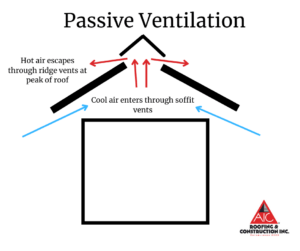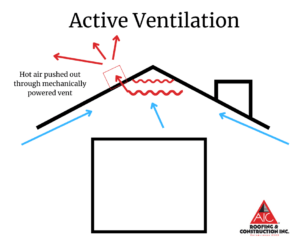Proper ventilation is critical to the longevity of your roof, especially with the summertime heat. But with so many choices, how do you select the appropriate roof vents for your home?
We want you to have the information necessary to make the best decisions for your new roof. By the end of this article, you’ll be more knowledgeable about roofing ventilation systems and feel confident selecting the right products for your home.
Why is Attic Ventilation Important?
Your roof’s ventilation system allows hot air to escape and keeps your attic from reaching damaging temperatures. During summer, rising hot air can cause attics to easily reach 170+ Fahrenheit. Sweltering temperatures can cause dry wood rot on your roof’s decking – warping the most foundational sheets of plywood supporting your roof.
Types of Roof Vents
Proper ventilation functions by bringing fresh, cool air into your attic and dispelling hot air through vents on the top of your roof. There are two types of ventilation systems – passive and active. There are several vent options available within each system. Customers may select roof vents based on appearance, cost, and/or maintenance.
Passive Ventilation Vents 
Passive ventilation works… well, passively. Air moves within this system based on natural forces. Vents are placed near the highest point on the roof to take advantage of wind movement and heat buoyancy. Cool air enters your home’s soffits, pushing out naturally rising hot air through the vents. Passive ventilation works without expending any energy – making it the green choice.
Types of vents that utilize passive ventilation include:
- Box vents (or turtle vents): Box vents get their name from their box-like appearance. They come in standard colors like black, brown, and clay. While box vents are less expensive than ridge vents, multiple box vents are required along the roof to achieve the temperature control given by a ridge vent installation. Box vents may be the best option for homes with a lower roof pitch or limited usable ridges.
- Turbines Vents: Turbines can be active (running on solar energy or electricity) or passive (relying on natural forces). Passive turbines use wind passing over your rooftop to drive the movement of the turbine. It draws air up and outward from your attic space. Outfitting a home with turbine vents can be comparable to ridge vents. However, depending on your home’s size and required ventilation, either choice could be cheaper. Turbines are the most visually intrusive vent option compared to ridge and box vents. If you want your roof to have a more subtle appearance, a turbine vent may not be suitable for your home. Also, it is essential to note that the bearings in the vent can wear out over time, reducing or even preventing the vent from turning altogether. This is why turbine vents should be inspected regularly to ensure they are spinning correctly.
Active Ventilation
Active ventilation removes hot air out of your attic by using force. This ventilation system is more expensive than passive vents as it requires a motor and energy (solar or electricity) to function.
- Ridge vents: Despite no motorized function, ridge vents are classified as active vents. Their ability to harness the natural airflow outside the home to generate airflow inside the attic meets the qualifications of active ventilation. Ridge vents are placed along the ridge of your roof, right at the “peak.” These vents are covered with matching shingles, almost completely disguising the vent system. We recommend these vents to our customers because of their efficiency, low maintenance, and subtle appearance. However, they may not be right for every home. If you have a much older house, additional updates may have to be made for a ridge vent to work properly. Additionally, ridge vents are more expensive than box vents. However, in our experience, on an average size roof, it would take 18 box vents to do the work of one 40’ section of ridge vent!
- Solar Powered Vents: This type of vent requires a solar panel in addition to the vent system. While this type of vent may be great from an energy savings perspective, the vent shuts off when the solar-powered battery needs charging. Furthermore, because a solar panel is necessary to run the vent, the system is larger and more expensive than other vent options.
- Power Vents: Power vents are installed near the ridge, or peak of your roof, and use electricity to draw hot air out of the attic. Power vents are typically circular shaped and have low profiles. Power vents are effective at dispelling hot air. However, it should be noted that the vent motor will fail at some point, so it’s essential to ask your roofing company about proper maintenance.
ROI
Ventilation is critical to your new roof. In our experience replacing thousands of roofs in the central Kentucky area, we’ve dealt with many different types of roofs and ventilation systems. Rest assured knowing that your new roofing project has a 100% return on investment (according to this 2022 National Association of Realtors Report) and is backed by our 10-year craftsmanship warranty.
We want to provide our customers with a best-in-class experience. Our Learning Center contains articles addressing every aspect of your new roof replacement, so you can feel confident making your roofing purchase. Ready to get started? Contact us today!
Default insurance Lexington Louisville Richmond roof replacement
